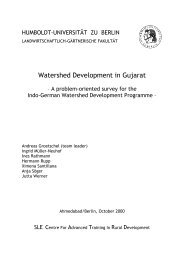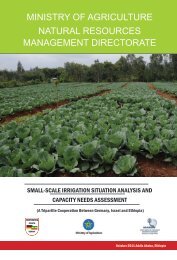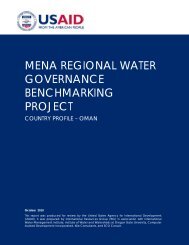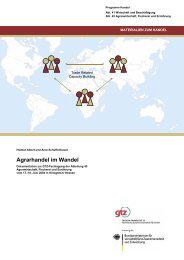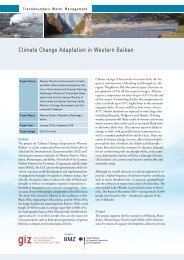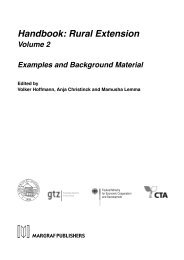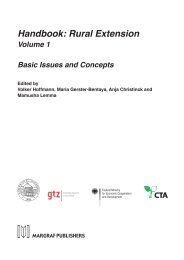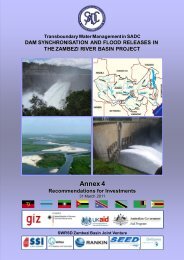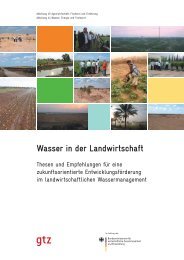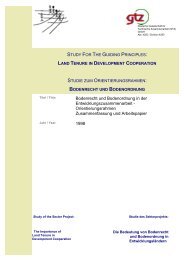Farming in the - WordPress.com
Farming in the - WordPress.com
Farming in the - WordPress.com
You also want an ePaper? Increase the reach of your titles
YUMPU automatically turns print PDFs into web optimized ePapers that Google loves.
Analysis of <strong>the</strong> agricultural situation <strong>in</strong> Azraq Bas<strong>in</strong><br />
German-Jordanian Programme “Management of Water Resources”<br />
55<br />
Water sav<strong>in</strong>gs through adoption<br />
of simple <strong>in</strong>novations<br />
1. Use of tuff as mulch (thickness<br />
5 cm, as a strip under stone fruit<br />
trees) <strong>in</strong> a farm <strong>in</strong> North Badia, is<br />
reported to allow water sav<strong>in</strong>gs up<br />
to 25% accord<strong>in</strong>g to an experiment<br />
that one farmer conducted on part<br />
of his farm.<br />
Use of tuff as mulch under stone<br />
fruits and olive trees.<br />
2. One farm <strong>in</strong> Azraq reported that<br />
by prepar<strong>in</strong>g its own <strong>com</strong>post<br />
from farm waste (weeds, branches<br />
after prun<strong>in</strong>g, cow manure) and<br />
<strong>in</strong>corporat<strong>in</strong>g it 50 cm deep before<br />
plant<strong>in</strong>g <strong>the</strong> trees, he could save up<br />
to 45-50% of water as it attracts<br />
<strong>the</strong> trees to develop deeper roots<br />
that grow to deeper soil layers, and<br />
soil reta<strong>in</strong>s more humidity.<br />
Production of <strong>com</strong>post from<br />
farm waste and <strong>in</strong>corporation of<br />
<strong>com</strong>post to soil preparation 70 .<br />
7.2. Projects to change <strong>the</strong><br />
cropp<strong>in</strong>g pattern: towards<br />
more water-efficient crops<br />
Water consumption versus possible<br />
economic return for many tree<br />
crops, field crops, and vegetable<br />
crops have been studied: <strong>the</strong><br />
conclusion was that <strong>the</strong>re needs to<br />
be a policy shift to water thrifty<br />
and salt tolerant crops <strong>in</strong> <strong>the</strong><br />
context of water scarcity, <strong>in</strong> order<br />
to support a water sav<strong>in</strong>g policy 71 .<br />
But based on our field <strong>in</strong>terviews,<br />
we saw that:<br />
1. In Mafraq, <strong>the</strong>re is a trend to<br />
switch from vegetables to fruit<br />
trees, not for water sav<strong>in</strong>g purposes,<br />
but to save work and get better<br />
profitability.<br />
2. In Azraq, most farmers are<br />
reluctant to switch to new crops<br />
s<strong>in</strong>ce olive trees are a long term<br />
<strong>in</strong>vestment. They would not remove<br />
<strong>the</strong>ir trees. They are not <strong>in</strong>terested<br />
<strong>in</strong> palm trees, and do not have<br />
enough technical and market<br />
knowledge about pomegranate to<br />
switch to this crop.<br />
Would farmers remove exist<strong>in</strong>g<br />
trees if <strong>the</strong>y are proposed an<br />
<strong>in</strong>terest<strong>in</strong>g alternative for ano<strong>the</strong>r<br />
higher added value crop? Is <strong>the</strong><br />
change of cropp<strong>in</strong>g pattern a good<br />
alternative? As it is <strong>com</strong>monly<br />
agreed that <strong>the</strong> expansion of<br />
farms should stop <strong>in</strong> order to limit<br />
water abstraction, is it not risky to<br />
propose <strong>in</strong><strong>com</strong>e generat<strong>in</strong>g crops<br />
for farmers who might be tempted<br />
to <strong>in</strong>crease <strong>the</strong>ir cultivated land<br />
<strong>in</strong>stead of replac<strong>in</strong>g exist<strong>in</strong>g not<br />
water effective crops?<br />
In any case, plann<strong>in</strong>g, fund<strong>in</strong>g,<br />
education, market<strong>in</strong>g, technical<br />
know-how and <strong>the</strong> will to execute<br />
any water conservation policy<br />
need to be addressed <strong>in</strong> more<br />
details before implement<strong>in</strong>g any<br />
conservation policy. If it is decided<br />
to encourage farmers to change<br />
<strong>the</strong>ir crops, <strong>the</strong>se crops should be<br />
selected accord<strong>in</strong>g to economical<br />
feasibility (detailed market study),<br />
suitability to <strong>the</strong> local environment<br />
(soil, water, climatic conditions)<br />
and water conservation potential.<br />
70 Also refer to 7.3.A – Compost Plant Project<br />
71 A water for peace strategy for <strong>the</strong> Jordan River by shift<strong>in</strong>g cropp<strong>in</strong>g patterns, Said A. Assaf, 2007



